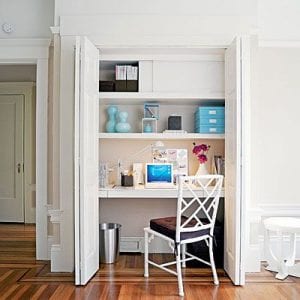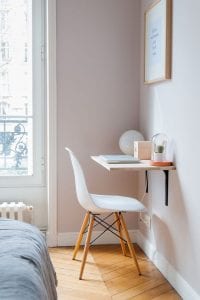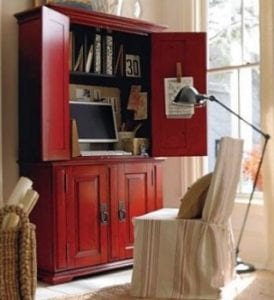Turn a Small Space Into a Functional Home Office
Working from home is now the norm for millions of workers. But converting your house to an office has its challenges. Here’s how to create a quick, easy, functional home office.
As many of us scramble to find space to work or study at home, the idea of a large home office becomes extremely appealing. In reality, of course, few of us have an extra room in our house just waiting for a desk, shelves, and office equipment. A comfortable, ergonomically sound chair may even be a luxury item.
But even if you have to get creative, dedicating space for a work-from-home office is important for productivity. Thankfully, you can create a functional home office without buying a bigger house. This article provides some basic musts when setting up a suitable work space in your home, and some tips for how to make the most of small spaces.
1. Depth
When commandeering a space for your home office, the first thing to do is take measurements. Will the space fit your work stuff? Can it hold a makeshift desk or some freestanding shelves? The space won’t work if it can’t hold you, your computer, and your essential office supplies. A good depth to shoot for is between 20 and 30 inches. Even if you have to install temporary shelving, make sure everything fits before deciding it’s the right space for you to work each day. You don’t want to feel uncomfortable in our own home office.
2. Electrical Power
Once you’re sure everything will fit, the next item to assess is access to power. How close is your tiny space to an electrical outlet? While your laptop or tablet can run on battery power most of the day, at some point you’ll need to charge devices. It’s easier if you can do that while still working. If necessary, purchase an extension cord. Make sure you choose one with surge protection and that fits your size and power requirements. Extension cords can be quite dangerous.
While you’re checking for power, it’s also a good time to test your WiFi. Are you near enough to the router that you get a reliable signal? If not, you may want to find an office space a little closer. Having a strong internet signal and basic electricity go hand-in-hand for a productive work environment. Also consider a WiFi extender to enhance the signal strength.
See also: Home Improvements While Working From Home=
3. Noise
It’s hard to work in a noisy environment. Even in a traditional office space, no one likes noisy neighbors. At home, noise can come from many locations. People, pets, and kitchen appliances can cause disruptions. If you can’t get total separation from these distractions, find a place that at least has some form of barrier between your desk and everyone else. Avoid setting up your office in a corner of the living room. However, if your office ends up in a shared space, try to create a schedule that calls for work hours when no one else is around. This means you take over the room, and others have to find somewhere else in the house to hang out.
4. Privacy
Aside from keeping the noise down, selecting a private location will also prevent unwanted intrusions. This increases your productivity, while also helping you get comfortable. A private location also means you won’t be interrupting others. If you have to be on a lot of calls, your family will appreciate not being part of the Zoom background.
5. Lighting
You may not know it but the type of lighting in your office can contribute to productivity. According to a recent Cornell University study, natural light is great for health, wellness, and productivity. If that’s not an option, choose the right artificial light. Avoid fluorescent lighting, which is a little harsh on the eyes. Opt for softer light like that given off by lamps. Floor, desk, or hanging lamps can help create the right lighting for your work space, and you can accessorize with different lamp shade styles and colors.
6. Style
Speaking of accessorizing, the aesthetic appeal of your home office is not just a superficial concern. Liking the way your space looks will have a positive outlook on your attitude. If you believe in feng shui, how you decorate and arrange your furniture will generate positive energy in the room. Consider having some photos and personal items as well. Choose colors, art, and furniture that you like and make you feel comfortable and at home.
Read more: The Sundae Guide to Design
7. Health and Ergonomics
Last but certainly not least, prioritize your physical health when you set up your home office. Keep water nearby. But try not to be too close to the kitchen or areas with a lot of food that might entice you to snack throughout the day. Take periodic breaks and move around a little bit.
Also, remember to follow ergonomic best practices. Try to do eye exercises a few times a day. Stand up and stretch (or get a convertible standing desk). Pick a good office chair at the right height. You don’t want to be hunched over your computer or work space, nor do you want to be leaning too far back. Make sure your feet touch the floor. Follow guidelines from experts to learn more.
Tips for making improvisational space
Have you looked around your home without any luck of finding the perfect work space? It may be harder than you thought to check off all the items on this list. If you can’t find the perfect space, create one from scratch.
Take over a small space in a big room
An office space doesn’t always mean a separate room. You can grab a bit of a larger room and make it your own.
- Rearrange the furniture. Set up one corner as your office. Use a piece of fabric to separate the space. When closed, you even get some additional privacy.
- Mount a console on the wall. It can do double-duty when placed well, serving as your desk and a display area. Slide up a chair when you need it, otherwise keep it off to the side to avoid clutter.
- Use a wall-mounted desk. These have a minimal footprint when space is scarce. They offer a flat work surface with no desk legs, drawers, or even a back. Some can fold up when not in use. No one will ever know you’ve got a home office in that corner.
- Place an armoire in the right spot. When closed up, they just look like another cabinet for storage. Open it and you’ve got a complete office that’s discreet with plenty of drawers (see photo above).
Create a ‘cloffice’
For many, the space that combines all the perfect features for a small home office is a closet. Repurposing an unused closet, or at least temporarily transforming one, makes for a serviceable office space. A “cloffice” easily contains all your work items. It has doors that you can close when it’s time to stop thinking about work for the day.
Every closet office is unique, so make sure you maximize the available space. Here are some suggestions:
- Get creative with the shape of your desk, find the right chair, and add shelving where necessary.
- Think about building up rather than out. If the doors complicate things, remove them. Replace them with a curtain you can pull back when work is in session.
- Give the space a little character by decorating the back closet wall. Paint it a bright color or apply self-adhesive wallpaper in a fun pattern.
- Bring the space together with creative storage solutions. Suspend hanging baskets from the closet rod to store items you’d usually put into your desk drawers. They’re great for holding extra pens, pencils, a stapler, tape despiser, and even printer paper.
Work from home as best you can
It’s not technically considered a home renovation, but creating a usable space to work remotely matters to homeowners now more than ever. Many of us are working from home for the first time, and a dedicated space is a must. Don’t settle for a seat at the kitchen table, or a spot in the middle of noisy children. Grab a space, no matter how small, and make it your own oasis where the work gets done.
Ready to Get Started?
Sell as-is. Pay zero fees to Sundae. Move on your time. No repairs, cleanings, or showings.



